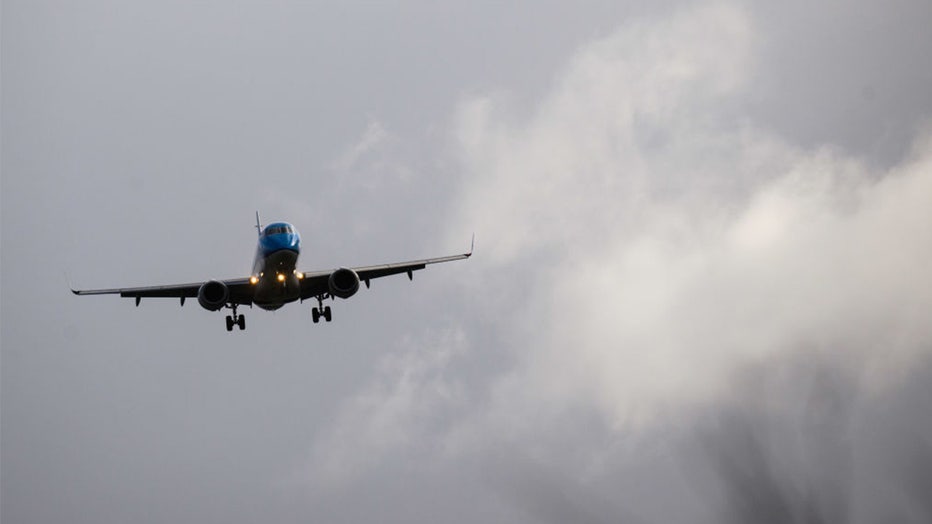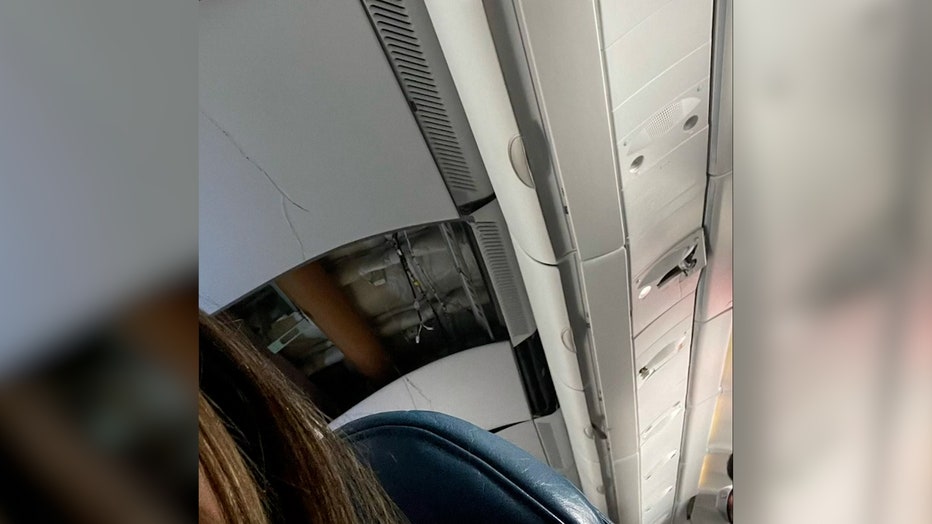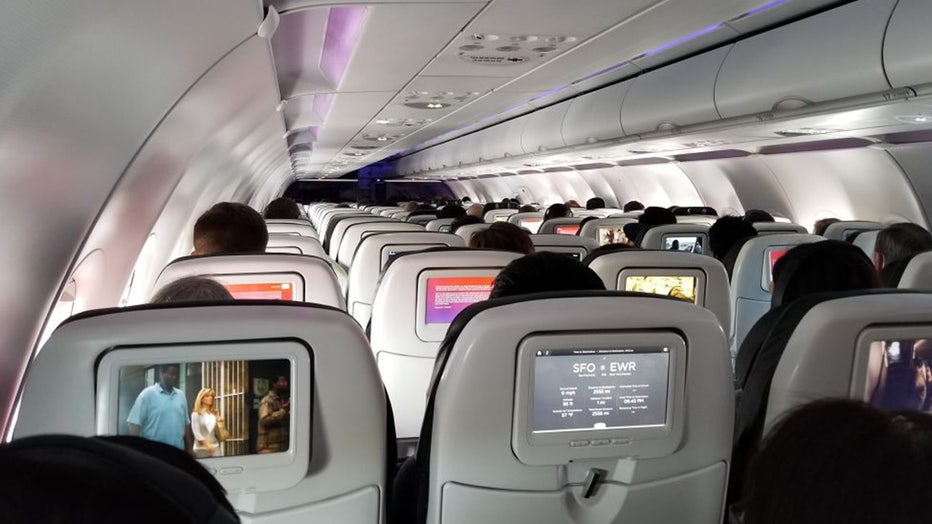Is turbulence happening more often?
FOX Weather addresses fears over turbulence in new documentary
FOX Weather's Jason Frazer spoke with LiveNOW from FOX's Josh Breslow about how a new special hopes to help calm fears over turbulence on an airplane.
Doesn’t it seem like incidents of severe turbulence have been happening more and more recently?
Some research that suggests climate change and the warming of our atmosphere are contributing to more frequent instances of turbulence on planes and will likely make it even more prevalent in the future.
But is it truly because they are happening more frequently or is it because we all have smartphones that allow us to document every second of our lives?
The answer to this is – a little of both.

FILE - An airplane lands in an inclined position as it lands. (Julian Stratenschulte/picture alliance via Getty Images)
What is turbulence?
You’ve all probably felt it, seen it in a video recently and hate it, but turbulence is unfortunately a necessary evil when it comes to flying.
And, just as you have been told time and time again, your aircraft is built to handle it, even if it doesn’t seem like it when you feel like you’re on a literal roller coaster 30,000 feet in the air.
Turbulence is essentially swirling pockets of air called eddies. These eddies can be random and sometimes chaotic, but again, it’s just air.
"We see them daily in bathtubs and cups of coffee," said Dr. Paul Williams, professor of atmospheric science at the University of Reading in the United Kingdom.
"When we fly through them, the air currents within the eddies push against the wings of the aircraft and bounce it up and down," Williams continued.
"In a nutshell, turbulence exists because there isn't enough friction to control the swirling motions. That's why highly viscous liquids such as honey usually don't contain turbulence (unless they are stirred very quickly)," Williams explained.
Is climate change causing more turbulence?
Atmospheric turbulence is the leading cause (71%) of all in-flight weather-related injuries and annually costs the United States $200 million, according to a recent study published in the journal Climate Dynamics.
Turbulence is more common during the winter months but with the use of three global climate modeling simulators, researchers posit that by the year 2050, turbulence will become as prevalent during the summer months if the atmosphere continues to warm.
"We have strong evidence that climate change is increasing the amount of turbulence in the atmosphere," Williams said.
Turbulence Terror: Hawaiian Airlines passengers describe experience on flight from Phoenix
A flight from Phoenix, Arizona to Hawaii was rocked by severe turbulence sending passengers and luggage flying. 36 people were injured, 11 of those people were taken to multiple emergency rooms in serious condition and 9 others were transported in stable condition. "We are continuing to support our guests and employees who sustained injuries today after Flight HA35 from PHX to HNL encountered severe turbulence," the airlines said in a statement on Twitter Sunday night. "We are also conducting a thorough inspection of the aircraft before returning it to service."
"A signature feature of climate change at flight cruising levels is that the tropics are warming faster than the polar regions. Therefore, the temperature difference between low and high latitudes is strengthening and driving stronger wind shears in the jet streams. This in turn enhances the formation of turbulent patches of air, which could triple because of climate change according to our calculations," Williams continued.
However, Williams noted that while there seems to be a strong correlation between warming temperatures and frequency of turbulence, more research is needed.
"We need more data before we can say whether climate change has impacted the frequency of turbulence on flights. That might sound like a contradiction, but aircraft are pretty good at avoiding turbulence, and are getting better all the time thanks to improved turbulence forecasts, so it doesn't necessarily follow that a more turbulent atmosphere will result in bumpier flights," he said.
"It's too early to definitively blame climate change for the recent apparent increases in turbulence. Increased media coverage, aided by in-flight video footage from passengers' mobile phones, may well be a factor," Williams added.
RELATED: Take a behind-the-scenes look at Delta Air Line's meteorology team
What is clear-air turbulence (CAT)?

Still images of damage following severe turbulence on a Hawaiian Airlines flight. ( jazminbitanga via Storyful)
You might have recently seen several videos of particularly violent instances of turbulence on commercial flights on social media, such as the flight from Austin, Texas, to Frankfurt, Germany, which sent food and belongings flying all over the aircraft.
Williams alluded to a statement from Lufthansa, the airline that experienced severe turbulence during a flight from Texas to Germany, which stated the incident was likely caused by clear air turbulence (CAT) and is considered one of the more dangerous weather-related hazards that pilots deal with.
"This kind of turbulence is invisible, even to the on-board weather radar, which means it can strike without warning when the seatbelt signs are switched off. It is generated by wind shears in the jet stream," Williams said.
Despite how scary it might feel when aircraft hit severe turbulence and it feels like you’re falling out of the sky, turbulence does not cause plane crashes.
There have been instances when severe turbulence has caused structural damage, but not a full-blown crash.
"Turbulence has not caused an airplane to crash," United Airlines pilot Rob Biddle told FOX Weather. "Airplanes are built very sturdily. In fact, there’s a lot of countermeasures built into the engineering of an airplane much like a car has different things to make a smooth ride on a bumpy road, airplanes have so many parts to it that’s built into the aircraft to be able to deal with and safely handle the turbulence."
Don’t worry, fly happy

FILE - Passengers use back-of-seat entertainment consoles while on a Virgin America flight. (Smith Collection/Gado/Getty Images)
Yes, turbulence is scary for many people, but think of them as just bumps in a road.
"Passengers on large airliners shouldn't be afraid of turbulence. Flying is arguably the safest form of transport. Passengers should always keep their seatbelts fastened when seated though, even when the seatbelt sign is off," Williams advised.
Just remember that modern aircraft are put through extreme testing that puts the aircraft to its limits in conditions far worse than any turbulence could produce.
Plus, pilots are put through the same amount of training and testing to make sure they know what to do when turbulence suddenly rocks the aircraft up and down or side to side.
FOX Weather contributed to this report. This story was reported from Los Angeles.

